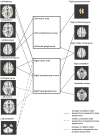Modulatory effect of acupuncture at Waiguan (TE5) on the functional connectivity of the central nervous system of patients with ischemic stroke in the left basal ganglia
- PMID: 24927275
- PMCID: PMC4057077
- DOI: 10.1371/journal.pone.0096777
Modulatory effect of acupuncture at Waiguan (TE5) on the functional connectivity of the central nervous system of patients with ischemic stroke in the left basal ganglia
Abstract
Objective: To study the influence of acupuncture at Waiguan (TE5) on the functional connectivity of the central nervous system of patients with ischemic stroke.
Methods: Twenty-four patients with ischemic stroke in the left basal ganglia were randomized based on gender to receive TE5 acupuncture (n = 12) or nonacupoint acupuncture (n = 12). Each group underwent sham acupuncture and then verum acupuncture while being scanned with functional magnetic resonance imaging. Six regions of interest (ROI) were defined, including bilateral motor, somatosensory, and bilateral basal ganglia areas. The functional connectivity between these ROIs and all voxels of the brain was analyzed in Analysis of Functional NeuroImages (AFNI) to explore the differences between verum acupuncture and sham acupuncture at TE5 and between TE5 acupuncture and nonacupoint acupuncture. The participants were blinded to the allocation.
Result: The effect of acupuncture on six seed-associated networks was explored. The result demonstrated that acupuncture at Waiguan (TE5) can regulate the sensorimotor network of the ipsilesional hemisphere, stimulate the contralesional sensorimotor network, increase cooperation of bilateral sensorimotor networks, and change the synchronization between the cerebellum and cerebrum. Furthermore, a lot of differences of effect existed between verum acupuncture and sham acupuncture at TE5, but there was little difference between TE5 acupuncture and nonacupoint acupuncture.
Conclusion: The modulation of synchronizations between different regions within different brain networks might be the mechanism of acupuncture at Waiguan (TE5). Stimulation of the contralesional sensorimotor network and increase of cooperation of bilateral hemispheres imply a compensatory effect of the intact hemisphere, whereas changes in synchronization might influence the sensorimotor function of the affected side of the body.
Trial registration: Chinese Clinical Trial Registry ChiCTR-ONRC-08000255.
Conflict of interest statement
Figures




References
-
- NIH Consensus Conference. Acupuncture. JAMA 280: 1518–1524. - PubMed
-
- Cheng XN (2000) Chinese Acupuncture and Moxibustion. Beijing: People’s Medical Publishing House.
-
- Han JS (2003) Acupuncture: neuropeptide release produced by electrical stimulation of different frequencies. Trends Neurosci 26: 17–22. - PubMed
-
- Liu P, Qin W, Zhang Y, Tian J, Bai L, et al. (2009) Combining spatial and temporal information to explore function-guide action of acupuncture using fMRI. J Magn Reson Imaging 30: 41–46. - PubMed
Publication types
MeSH terms
LinkOut - more resources
Full Text Sources
Other Literature Sources
Medical

